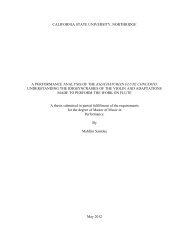2644 - CSUN ScholarWorks - California State University, Northridge
2644 - CSUN ScholarWorks - California State University, Northridge
2644 - CSUN ScholarWorks - California State University, Northridge
You also want an ePaper? Increase the reach of your titles
YUMPU automatically turns print PDFs into web optimized ePapers that Google loves.
Journal of Student Research Abstracts · 39<br />
within the dead tobacco infectious. A similar control solution was made without the buffer. After 3 weeks of<br />
growth, the plants were infected with TMV with a sterile brushing of the inoculum on the leaves. TMV causes<br />
quantifiable lesions in pinto (Phaseolus vulgaris). Lesion counts were daily taken, and while significant differences<br />
appeared initially, after complete virus propagation, no significant differences existed in the number<br />
of lesions per square centimeter. Zinc seems to slow viral attack, but at this concentration does not stop the<br />
virus. Subsequently, to see if more slowing would occur with more zinc, a similar trial was done with varying<br />
zinc nitrate concentrations. With an identical technique, 3 groups were grown with either distilled water, 5 ppm<br />
zinc nitrate or 50 ppm zinc nitrate. After infection, the higher zinc concentration showed much slower symptom<br />
emergence than the water and 5 ppm zinc groups. But in the end results showed no significant difference.<br />
Thus, according to this data, zinc's presence slows the propagation ofTMV in pinto plants.<br />
2722<br />
THE EFFECT OF VITAMIN K ON THE LEARNING RATE OF PLANARIA.<br />
Michelle Thomas, and Steve DeGusta (teacher). John F. Kennedy High School, 6715 Gloria Drive,<br />
Sacramento, CA 95831.<br />
This experiment was done to determine if vitamin K made planaria learn faster. This experiment compared<br />
the learning rate of planaria exposed to 0.0012% vitamin K solute with a control group of normal planaria. The<br />
planarian training consisted of exposure to a brief pulse of light followed by an electric shock. This process<br />
was repeated 25 times daily until the planaria reacted to the light as it would to shock 75% of the time. After<br />
the planarian responded correctly 75% in one test consisting of 25 light shock repetitions it was said to have<br />
learned the condition. No significant differences were found in the learning rates of the two groups of planaria<br />
(0.9>P>0.5). This investigation found that vitamin K did not increase the learning rate in which planaria learn.<br />
2723<br />
NUTRITION STUDIES WITH RED WORMS.<br />
Ryan Sunahara, Steve DeGusta (teacher). John F. Kennedy High School, 6715 Gloria Drive, CA 95831.<br />
In my lab, I tested Red worms and their diets to see if it affected their growth rate. I gathered forty worms<br />
and placed them in forty different petri dishes. Each dish contained peat moss for their bedding and their<br />
assigned diet. There are three different diets: fish food, com starch, and fish food plus com starch. I also had<br />
one petri dish with only peat moss for my control. Before placing the worms in the dish, I measured their initial<br />
lengths by carefully laying them against a ruler. After ten days of living in their petri dish environment, I<br />
measured the new lengths of the worms. After another seven days, I measured the worms once again. I found<br />
that the fish food plus com starch group had the greatest growth rate among the four groups. The fish food<br />
group, com starch, and control group were in descending order of growth rates respectively. The results that I<br />
received were as expected. The fish food plus corn starch diet was the most balanced of the three other diets<br />
and, therefore, it had the largest growth rates among the worms. A few worms in each group did die and were<br />
disregarded when doing the statistics. All the worms that were alive at the end of the two and half week period<br />
had grown between 0.4 em and 1.1 em. Using statistics, I found that my measurements in lengths of the<br />
worms had no significant difference between the groups. Although all the worms did grow, the difference<br />
between the groups were found to be insignificant.













